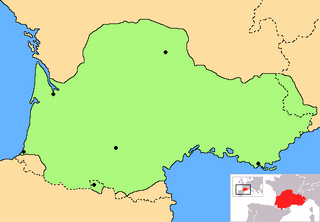
Occitan, also known as lenga d'òc by its native speakers, is a Romance language spoken in Southern France, Monaco, Italy's Occitan Valleys, as well as Spain's Val d'Aran; collectively, these regions are sometimes referred to as Occitania. It is also spoken in Southern Italy (Calabria) in a linguistic enclave of Cosenza area. Some include Catalan in Occitan, as the distance between this language and some Occitan dialects is similar to the distance among different Occitan dialects. Catalan was considered a dialect of Occitan until the end of the 19th century and still today remains its closest relative.
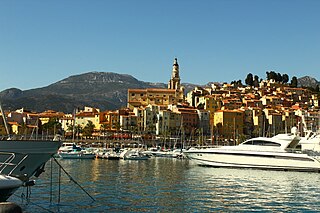
Menton is a commune in the Alpes-Maritimes department in the Provence-Alpes-Côte d'Azur region on the French Riviera, close to the Italian border.

Occitania is the historical region in Western and Southern Europe where Occitan was historically the main language spoken, and where it is sometimes still used, for the most part as a second language. This cultural area roughly encompasses the southern third of France, as well as part of Spain, Monaco, and smaller parts of Italy. Occitania has been recognized as a linguistic and cultural concept since the Middle Ages, but has never been a legal nor a political entity under this name, although the territory was united in Roman times as the Seven Provinces and in the Early Middle Ages.
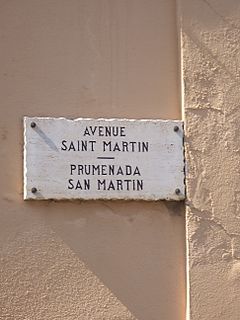
Monégasque is the variety of Ligurian spoken in Monaco, where it is considered a national language, even though it is not the official language of the country (French).
Brigasc is a dialect of the Ligurian language. It is spoken in Italy and France.
Niçard, nissart/Niçart, niçois, or nizzardo is the dialect that was historically spoken in the city of Nice, in France, and in all the area of the historical County of Nice. It is a subdialect of Provençal, itself a dialect of Occitan.

Ligurian or Genoese is a Gallo-Italic language spoken primarily in the territories of the former Republic of Genoa, now comprising the region of Liguria in Northern Italy, parts of the Mediterranean coastal zone of France, Monaco, the village of Bonifacio in Corsica, and in the villages of Carloforte on San Pietro Island and Calasetta on Sant'Antioco Island off the coast of southwestern Sardinia. It is part of the Gallo-Italic and Western Romance dialect continuum. Although part of Gallo-Italic, it exhibits several features of the Italo-Romance group of central and southern Italy. Zeneize, spoken in Genoa, the capital of Liguria, is the language's prestige dialect on which the standard is based.
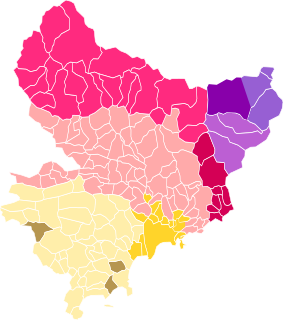
Mentonasc is a Romance dialect historically spoken in and around Menton, France. It is classified as a dialect of Occitan and a sub-dialect of Vivaro-Alpine, with some strong influence from the neighbouring Intemelian Ligurian dialect spoken from Ventimiglia to San Remo.
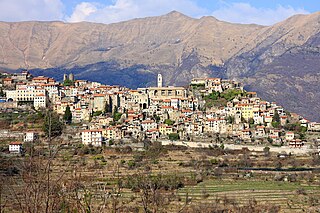
Triora is a comune (municipality) in the province of Imperia in the Italian region Liguria, located about 100 kilometres (62 mi) southwest of Genoa and about 25 kilometres (16 mi) northwest of Imperia, on the border with France. As of 31 December 2004, it had a population of 416 and an area of 68.0 square kilometres (26.3 sq mi).

The Occitano-Romance or Gallo-Narbonnese, or rarely East Iberian, is a branch of the Romance language group that encompasses the Catalan/Valencian, Occitan languages spoken in parts of southern France and northeastern Spain.

The Roya, Roia (Italian), or Ròia is a river of France and Italy, discharging into the Ligurian Sea. It is 59 km (37 mi) long, of which 40.1 km (24.9 mi) in France. Its drainage basin is about 660 km2 (250 sq mi), of which 601 km2 (232 sq mi) in France.
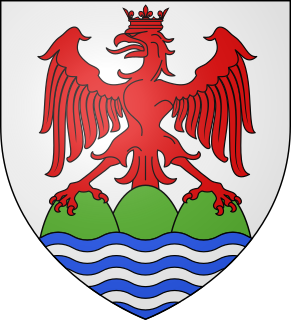
Italian irredentism in Nice was the political movement supporting the annexation of the County of Nice to the Kingdom of Italy.

La Brigue is a commune in the Alpes-Maritimes department in southeastern France.

The Croissant is a linguistic transitional zone between the Langue d'oc dialects and the Langue d'oïl dialects, situated in the centre of France where Occitan dialects are spoken that have transitional traits toward French. The name derives from the contours of the zone that resemble a croissant, or crescent.

Intemelio is a Ligurian dialect spoken historically from the Principality of Monaco to the Italian province of Imperia.

Joan Francés Fulcònis was a mathematician born in Lieusola ca 1520 and who lived in Nice. He is the author of La Cisterna Fulcronica, a treaty of arithmetics written in Occitan language and printed in Lyon in 1562.

Passo Tanarello or Pas du Tanarel at 2,042 m is a mountain pass in the Ligurian Alps. It connects the valleys of Roya in France and Tanaro in Italy.
The Bourbonnais dialects are spoken in the historic region of Bourbonnais, located in central France and including the department of Allier the area surrounding Saint-Amand-Montrond, in southeastern Cher. This linguistic zone is located between those home to the languages of Oïl, Occitan, and Franco-Provençal.

Monte Bertrand (Italian) or Mont Bertrand (French) is a mountain located on the French-Italian border between Piemonte and Provence-Alpes-Côte d'Azur.

Niçard Italians are Italians who have full or partial Nice heritage by birth or ethnicity.


















